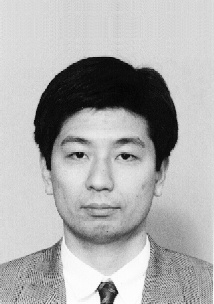
| Tomohiro Kudoh Parallel and Distributed System Architecture TRC Laboratory |

| Tomohiro Kudoh Parallel and Distributed System Architecture TRC Laboratory |
Profile Affiliation: Parallel and Distributed System Architecture TRC Laboratory, RWCP Tsukuba Research Center Date of birth: January 1, 1963 Birthplace: Kumamoto City, Kumamoto Prefecture Background: March 1991 Completed the Doctorate Course of Science and Technology, Keio University. April 1991 Assigned as a lecturer of the Information Technology Department of the Tokyo Engineering University. October 1996 Appointed as an associate professor of the Tokyo Engineering University. April 1997 Joined the Real World Computing Partnership. "Food I don't like": Pineapple
I was a third year junior high school student when I took an interest in computers for the first time. I was not so diligent in preparing for entry examinations and often dropped into a bookstore for a breather. I am still afraid that it may have been one of the biggest mistakes in my life, that I happened to find a book at the bookstore. The book was about the TK-80, an NEC single-board microcomputer which once ruled the age (incidentally, the word "personal computer" was not in use those days).
At senior high school, I joined a "physics club." In reality, however, it was a "microcomputer circle." I found that the circle members were working on the assembly of a microcomputer with Motorola's 6800 microprocessors. It was really exciting for me to take part in that work.
Reflecting on those days, I believe it was not quite possible for us to build a system which could steadily run because we did not have sufficient technical background and had to grope our way along, merely relying on magazine articles. Yet, I was happy every day.
This motivation and energy at that time pushed me to take the computer course at the university. Since then, I have devoted myself solely to the study of computer technology.
Reviewing the past development of computers, I suppose that computer complexity has grown tremendously as compared with the primitive machines I tampered with during my high school days. As a result, "black box" parts are rapidly increasing in number.
Of course, I didnšt have much knowledge about the operation of devices when I was in a senior high school. However, I knew every aspect of parts that digitally operated, including programs.
ication programs, and what is really required. Taking this into consideration, together with the fact that a single person cannot understand a whole computer system, it will become obvious that specialists of different fields must work as a single body to build a system.
At the Parallel and Distributed System Architecture Tsukuba Laboratory, researchers are actively engaged in the development of computer architecture which can manage computer resources, such as a memory, by using the global address space for computers interconnected via a high-speed network. In this field, the key to the development of a more efficient system depends on whether or not we can identify what can be done with the compiler and the OS, and what must be supported by the hardware. It is also essential to accurately evaluate what performance can be achieved when an application program actually runs on the system.
Fortunately, we have many specialists with various backgrounds in RWCP. So, I would like to build a parallel and distributed system into which a great deal of disciplines and technologies in each field will be invested.